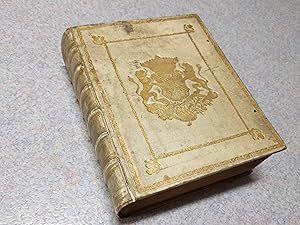A propos de cet article
4to. 2 parts in 1: (XVI),829 (recte 807),(1 blank); 79,(4 index),(1 blank); 110,(153 index),(1 blank) p. Frontispiece. Vellum. 24 cm 'Prize copy with the manuscript prize' (Ref: STCN ppn 203443551; Schweiger 2,979; Ebert 21933; cf. Moss 2,631; cf. Dibdin 2,441; cf. Fabricius/Ernesti 2,458/59; Brunet 5,582; Spoelder p. 711, IJsselstein 2) (Details: Back with 5 raised bands. Binding gilt, and with the gilt coat of arms of IJsselstein on the boards. Including the prize. The frontispiece, dated 1703, depicts Suetonius at work at a desk in what looks like the Pantheon. Woodcut ornament on the title-page. Numerous woodcut illustrations of medals and coins in the text) (Condition: Vellum soiled and age-toned. All 4 decorative silk fastening ribbons worn away. Paper yellowing) (Note: The editor of the Suetonius edition is Johann Georg Graeve, or in Latin Johannes Georgius Graevius, 1632-1703. He was professor of Eloquence at Duisburg, from 1657 at Deventer and from 1661 at Utrecht, where he lived and worked for the last 40 years of his life. He limited his attention mainly to writers of Latin prose, Cicero, Suetonius, Caesar, Justinus, Florus. This scholar of international stature is remembered above all for his 'Inscriptiones antiquae', long time a standard edition. He is also famous for his three 'Thesauri', in which important works of previous leading scholars were collected and reprinted, the 'Thesaurus eruditionis scholasticae', the 12 folio volumes of the 'Thesaurus antiquitatum Romanarum', and the 9 volumes 'Thesaurus antiquitatum et historiarum Italiae'. § Graevius produced 3 Suetonius editions, the first appeared in 1672, his second in 1691 and finally a third in 1703. This title on offer of 1708, is a reissue of the edition of 1703. Van Poolsum apparantly acquired the unsold copies of the 1703 edition, replaced only the first 2 leaves, and brought it again on the market under his own name. § The text of Suetonius (the 'Vitae', 'De illustribus grammaticis liber' and 'De claris rhetoribus liber') is followed by 14 pages and 2 folding tables with inscriptions to illustrate the 'Lives', and 54 pages with the commentary of Graevius; then follows the commentary of 79 pages by Carolus Patinus, with nice illustrations of coins. This is followed by a 70 p. commentary of the Dutch scholar Theodorus Marcilius on Suetonius' biography of Vespasian. This is again followed by a small section with the prefaces to Suetonius by Politianus and Casaubon, and Vossius' article on Suetonius from 'De historicis Latinis'. Included is also the text of the 'Monumentum Ancyranum', with Isaac Casaubon's commentary; at the end a 153 page index compiled by Matthias Berneccerus § Graevius inserted, as mentioned above, the entire commentary of Carolus Patinus, or Charles Patin, 1633-1693. In 1676 this Frenchman was appointed professor of philosophy at the university of Padua, and later of medicin and surgery. He made his fame however with his books on numismatics, and became a well known authority upon the subject of coins and medals. He published on Roman families and emperors on coins and medals. He possessed a collection of his own, because in Amsterdam in 1672 was published on his own expense his 'Thesaurus numismatum e Museo Caroli Patini'. (Handbuch Gelehrtenkultur der frühen Neuzeit, Berlin 2004, vol. 1, p. 497/8) Patin must also have been a wealthy man, because his own Suetonius edition of 1675 (Basel), which seems to be a 'spin off' of his great knowledge of imperial coins, was also printed on his own expense. § The Roman historian Suetonius, born c. 69 A.D, is the most influential and best known biographer in the Latin language. He was appointed secretary to the emperor Hadrian, a job that gave him access to the imperial records and archive. He made good use of his sources, writing the Lives of the XII Caesars, or 'De vita Caesarum'. The collection consists of the biographies of 12 emperors, from Caesar, the founder of the imperial line, to Domiti.
N° de réf. du vendeur 159116
Contacter le vendeur
Signaler cet article




